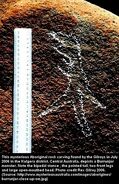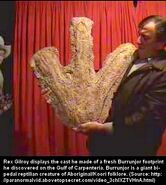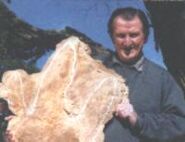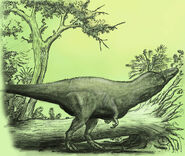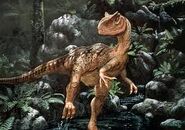
Burrunjor
The Burrunjor is an Australian dinosaur cryptid that resembles the theropod dinosaur T. rex, or maybe a megaraptorid like Australovenator, Megaraptor, or Rapator, but it could also be a dinosaur that has so far not appeared in the fossil record. The Burrunjor is described as being a giant lizard according to aboriginal mythology. Based on sightings it is 20-25 feet long, has small clawed hands and is bipedal in nature. Throughout the 1950s, Australian cattle ranchers reported a large creature leaving bipedal tracks was eating their livestock. Also, earlier aboriginal accounts suggest that is it a reptilian animal (possibly with feathers) whose diet consisted of kangaroos and other large animals. If it was not for the bipedal footprint findings, the burrunjor could have been mistaken for a Megalania (Varanus priscus), a prehistoric giant monitor lizard that lived in the area more recently, based on the aboriginal description.
Sightings
- The last sighting of the Burrunjor happened in 1985 when a family was traveling to Roper River and they reported see a 20 foot long monster covered in feathers.
- Another report tells of man named Bryan Clark who went into the woods and got lost sometime during 1978; after the alarm was raised, he was tracked by policemen and two aboriginal bushmen. The trackers woke up one night to a loud thunderous sound and the ground shaking. After finding the wayward traveller, policemen later told the man that if he ever went back into the woods and got lost that they would not come looking for him. Some think the sound was the stomping of the Burrunjor; however, a light-footed theropod dinosaur would not crash around the undergrowth in this manner, despite what certain Spielberg movies would have the public believe.
Are people still seeing the Burrunjor?
There have been no sightings of this creature in more than 30 years; at least no one that has seen it has come forth. This has lead many to think that if it once existed, it has since became extinct. But no Remains have been found.
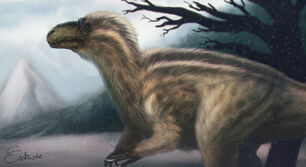
Gallery
Sources and links for researchers
- Tyrannosaurus rex article on Wikipedia
- Australovenator article on Wikipedia
- Megaraptor article on Wikipedia
- Rapator article on Wikipedia
- https://www.genesispark.com/exhibits/evidence/cryptozoological/the-therapod-enclosure/the-burrunjor-of-australia/
- http://tylerscryptozoo.blogspot.com/2016/05/the-burrunjor-present-day-australian.html

